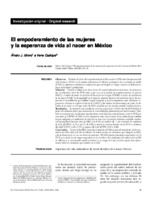El empoderamiento de las mujeres y la esperanza de vida al nacer en México
| dc.contributor.author | Idrovo, Alvaro J | es_ES |
| dc.contributor.author | Casique, Irene | es_ES |
| dc.date.accessioned | 2015 | |
| dc.date.available | 2015 | |
| dc.date.issued | 2006 | es_ES |
| dc.identifier.citation | Idrovo, Alvaro J,Casique, Irene (2006) El empoderamiento de las mujeres y la esperanza de vida al nacer en México. Rev Panam Salud Publica;20(1) 29-38,jul. 2006. Retrieved from http://www.scielosp.org/scielo.php?script=sci_arttext&pid=S1020-49892006000700004 | es_ES |
| dc.identifier.uri | http://www.scielosp.org/scielo.php?script=sci_arttext&pid=S1020-49892006000700004 | es_ES |
| dc.identifier.uri | https://iris.paho.org/handle/10665.2/7950 | |
| dc.format.extent | graf | es_ES |
| dc.relation.ispartofseries | Rev Panam Salud Publica;20(1),jul. 2006 | es_ES |
| dc.subject | Expectativa de Vida | es_ES |
| dc.subject | Direitos da Mulher | es_ES |
| dc.subject | Mexico | es_ES |
| dc.title | El empoderamiento de las mujeres y la esperanza de vida al nacer en México | es_ES |
| dc.type | Journal articles | en_US |
| dc.rights.holder | Pan American Health Organization | en_US |
| dc.description.notes | OBJETIVOS: Evaluar el efecto del empoderamiento de las mujeres (EM) sobre la esperanza de vida al nacer (EVN) en los estados federativos de México y comparar los resultados de medir el EM con diferentes indicadores compuestos que privilegian en mayor o menor medida un enfoque individual o poblacional. MÉTODOS: Estudio ecológico con datos de los 32 estados federativos mexicanos. Se estimaron las correlaciones entre la EVN total y por sexo y la medida de empoderamiento de género (MEG), el índice de poder de decisión de la mujer en el hogar (IPDH), el índice de autonomía de la mujer (IAM), la desigualdad en el ingreso, algunos factores del ambiente físico, la proporción de la población que hablaba lengua indígena y la tasa migratoria neta. Mediante regresiones robustas se exploró el efecto de la MEG y los índices de autonomía y de poder de decisión de la mujer en el hogar sobre la EVN, ajustado por las demás variables independientes. RESULTADOS: Se encontró una correlación inversa muy fuerte (-0,93) entre la EVN total y el factor del ambiente físico que caracteriza la vulnerabilidad poblacional y la biodiversidad. También se encontraron correlaciones significativas, tanto directas como inversas, entre la EVN por una parte y el IPDH, el IAM, la tasa migratoria neta, el porcentaje de la población que hablaba lengua indígena y el coeficiente de Gini por la otra. Las regresiones robustas múltiples mostraron asociaciones inversas entre la MEG y la EVN en mujeres (beta: -1,44; intervalo de confianza de 95 por ciento [IC95 por ciento]: -2,71 a -0,17). El IAM se asoció de manera directa con la EVN en hombres (beta: 0,88; IC95 por ciento: 0,01 a 1,75) y mujeres (beta: 0,66; IC95 por ciento: 0,03 a 1,30). CONCLUSION: El uso de la MEG como aproximación al EM no puso de manifiesto efectos positivos del EM sobre la EVN en México. Se deben revisar los elementos que integran la MEG y la pertinencia de su uso en diversos contextos. El IAM mostró una mayor asociación con la EVN y su efecto fue de mayor magnitud en los hombres. Este indicador permitió medir la EM en México y se recomienda usarlo mientras no se tenga otro que permita captar más eficazmente todos los elementos que inciden en el EM.(AU) | es_ES |
| dc.description.notes | OBJECTIVES: To assess the effect of women's empowerment (WE) on life expectancy at birth (LEB) in the federative states of Mexico and to compare the results of measuring WE with various compound indicators that reflect, to a greater or lesser degree, an individual or population focus. METHODS: This was an ecological study conducted in Mexico's 32 federative states. We estimated the correlations between overall and sex-specific LEB on the one hand, and a measure of gender empowerment (MGE), the index of women's ability to make decisions within the household (WADH), the index of women's autonomy (IWA), income inequality, certain aspects of the physical environment, the proportion of the population who spoke an indigenous language, and the net migratory rate on the other. By using robust regressions, we studied the effect on LEB of MGE, IWA, and WADH, after mutually adjusting for other independent variables. RESULTS: A very strong inverse correlation (-0.93) was found between overall LEB and factors of the physical environment linked to population vulnerability and biodiversity. Significant direct and inverse correlations were also found between LEB on the one hand and WADH, IWA, net migratory rate, the percentage of the population that spoke an indigenous language, and the Gini coefficient on the other. Multiple robust regressions showed inverse associations between MGE and LEB in women (beta: -1.44; 95 percent confidence interval [95 percent CI]: -2.71 to -0.17). WAI was positively associated with LEB in men (beta: 0.88; 95 percent CI: 0.01 to 1.75) and women (beta: 0.66; 95 percent CI: 0.03 to 1.30). CONCLUSION: The use of MGE as a surrogate for WE failed to reveal a positive effect of WE on LEB in Mexico. It is necessary to review the components that make up MGE and the relevance of using such a measure in different contexts. WAI showed a greater association with LEB and its effect was greater among men. This indicator made it possible to measure WE in Mexico and its use is recommended, as long as there are no other indicators available for capturing more effectively all the components that affect WE.(AU) | en_US |
Files in this item
This item appears in the following Collection(s)
-
Pan American Journal of Public Health
Revista Panamericana de Salud Pública

